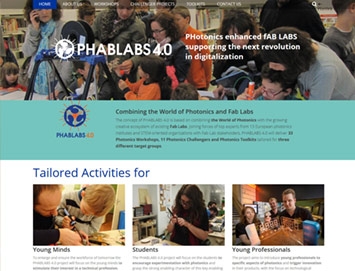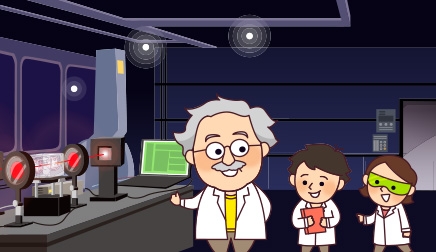 Home > Professor lights > Vol.05 Hugo THIENPONT
Home > Professor lights > Vol.05 Hugo THIENPONT
Vol.05 Hugo THIENPONT
Spreading the value and appeal of photonics around the world from Belgium!

Prof. Hugo Thienpont
Director of Brussels Photonics (B-PHOT)
In 1984, he started his career as a doctorate student majoring in applied physics. In 1990, he received a PhD and a few years later became a professor. Currently he serves as a vice-director of the Vrije Universiteit Brussel where he is in charge of collaborative efforts between the university and industry, while also working as the director of the Brussels Photonics team (called B-PHOT) to carry out basic and applied research on photonics and research into industrial applications.
In Europe, a learning kit is available that helps middle school students learn optical engineering (hereinafter “photonics”) while experimenting on their own or in small groups. All kits are funded by corporate donations and sent to schools in various areas around the country. Using this kit, kids can learn optical engineering and technology almost instinctively. A person who is strongly promoting the development and spread of this kit is Prof. Hugo Thienpont, vice-director of the Vrije Universiteit Brussel (VUB) or Free University of Brussels in Belgium. He has believed in the possibilities offered by photonics since its earliest days and has been working to foster photonics engineers and promote collaborative efforts with industry.
Here in Professor Lights Vol. 05, we shine some light on Prof. Thienpont’s energetic activities in photonics.
Making photonics a major issue
Putting the whole research lab on display in an exhibition hall
Aiming to spread the Photonics Explorer kit far and wide
The kit gives the girl students confidence
What’s important is to keep on moving ahead
Classrooms where kids can find a teacher they admire
Changing the world by fusing other technologies with photonics
Who needs lasers?
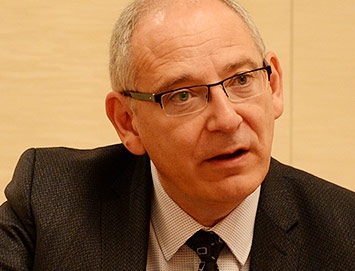
“I first felt an interest in optics going back some 30 years ago,” says Prof. Thienpont at the start of our interview. ”I was originally an engineer and 30 years ago the mainstream in the engineering field was electronic engineering and mechanical engineering. Optics was a special field at that time, ranked along with nuclear physics in the field of applied physics.”
In those days, advances were slowly and steadily being made in developing laser diodes and optical fibers. However, most people thought that lasers were superb light sources but had few applications. That was the reason why Prof. Thienpont decided to choose optics. He explains, ”I thought it was nice because there were almost no existing applications so I could start from scratch. I figured this would create a great opportunity for totally new applications.”
In 1990, Prof. Thienpont received a PhD in nonlinear optics. He comments, “I believed that future industry would need a whole new type of engineer. Rather than classical optics, photonics engineers capable of covering an even wider field would be needed.” Whereas classical optics relied on the lens, photonics would rely on advanced devices including lasers, sensors and detectors, and the scope this area covers would be huge compared to the traditional approach.
Taking this as a launching point, Prof. Thienpont established a master’s course in photonics at the Vrije Universiteit Brussel in 1994.
“When I said I wanted to create a master’s course, my colleagues at the university all told me I was crazy. They said things like, ‘Who needs lasers?’ ‘Who needs photonics?’ ‘Nobody is telling us they want such a thing!’” comments Prof. Thienpont.
However, Prof. Thienpont had no doubts about the path he should take and was strongly convinced that photonics would definitely become a new trend. He says looking back on that time, “Senior professors told me that this was not the way to go. But fortunately, they let me do what I wanted.”
However, the new generation of students at the university had a completely different reaction. Many students came to hear his presentations on photonics and were enthusiastic about it, giving comments like, “This is something very different from the classical mechanical engineering and electronic engineering.” In one or two years of time, a lot of students decided to enter this new field. The number of those students soon reached 15 to 20 per year. For a middle-sized university like the Vrije Universiteit Brussel, this was a big success.
Making photonics a major issue
Prof. Thienpont next aimed at making photonics take shape in a way everyone could see. This was also a way to show its appeal to industry. “I then invited industry people likely to have something to do with optics and photonics and decided to hold round-table discussions. I also invited members of the press.” Prof. Thienpont thought the industry people would give comments like, ‘Yes, photonics is the future! From now on we will be needing photonics engineers!”
However, things did not go so smoothly.
Those people invited from industry all said the same thing, “We don’t need photonics engineers. We need engineers who have studied mechanical engineering or electronic engineering or have a broad ranging industrial education. Knowledge of optics or photonics might become necessary, but most engineers will be able to learn it after entering the company.” And unfortunately, no one at all said, “Yes, we do want photonics engineers.” Prof. Thienpont comments, ”So I really scratched my head. Especially since I had invited the press. This was not a good move.”
However, things had changed by the time the first photonics engineering students were graduating and finding a job. Businesses involved in this field were starting to boom. “So, when the very first job offers for photonics engineering students started to come, I made many copies of these job offers and posted them up around the university to show that optical engineers and photonic engineers were needed by industry and society,” continues Prof. Thienpont.
Shortly after that the phones in Prof. Thienpont’s research lab began to ring nonstop. “Do you have any graduated students with majors in optics and photonics that have not yet found a job?” “Or students who will be graduating soon?” “Our company wants to hire your best students.” These kinds of phone calls from various companies kept coming and never seemed to stop.
For example, companies involved in making high-level projector systems, companies making LED display walls, or telecommunications firms were all searching for photonics engineers. Companies in the biotechnology and medical fields, and even in the printing industry also were looking for help. Everyone wanted these new types of engineers who had studied photonics and optical engineering.
“Our university was the only place on the European continent that delivered engineers capable of meeting these kinds of industry needs. They were engineers understanding classical optics, optical fibers, and measurement technology, and who were capable to actually make use of these technologies.”
“Have hands-on experience in using optic equipment and photonics instrumentation.” That was what Prof. Thienpont always insisted on. “I instructed the students to actually use equipment such as lasers, LED, and detectors. I used some funding for research work to cover these educational costs. This was quite a revolutionary and innovative step as seen by industry, because it had been common practice that engineers who just graduated from university had no practical knowledge even though they acquired excellent theoretical knowledge in the classroom,” says Prof. Thienpont.
In the field of photonics, this fusion of theory and practical work yielded great results. However, Prof. Thienpont was already looking beyond that point. Namely, rather than just sending engineers to industry, he wanted to start collaboration with industry. The most effective method for expanding and developing research themes from university study was by teamwork with industry.
Putting the whole research lab on display in an exhibition hall
“My goal was to really collaborate and work with industry. I then hit upon a scheme that might appear crazy to others,” he continues.
A large-scale exhibition with the name "Flanders Techno Land" was scheduled to be held in the Flanders region of Belgium. This was a very large exhibition with many visitors from both industry and from the general public. “I decided to put my whole research laboratory on display in that exhibition. This involved providing optical tables, lasers, and all their equipment in addition to some 20 staff members and graduating students,” he says.
There was a good reason that Prof. Thienpont was able to reserve 120 square meters of space at his very first exhibition even with other famous companies competing for product exhibit space. “From the Vrije Universiteit Brussel, a professor who was researching electric vehicles had already reserved exhibit space. This professor was a really visionary person and had received exhibit requests from many countries including Italy, Sweden and Germany. However, he had in fact been invited to so many exhibitions that he could not make it to the Flanders Techno Land” exhibition. The university faced a problem, because there was nothing to show in the 120 square meters of booth space reserved. So I raised my hand, “I’ll take it.”
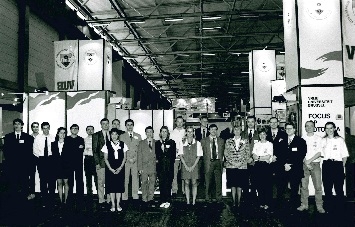
Many people from industry visited Prof. Thienpont’s research lab booth, which was titled “Focus on Photonics”. Managers from large companies such as BARCO (*1) dropped by his booth and asked “What are you doing here?” He and his staff answered, “We are involved in photonics and are researching lasers and new types of light.” Hearing this one manager said, “That is exactly what we have been searching for. How about meeting us next week?”
“Our reply was of course ‘Yes’ but we faced still another problem. If they came to our research lab next week, we would have to take our entire exhibit home with us in a hurry,” laughs Prof. Thienpont. Anyway, the following week this manager along with his company staff visited Prof. Thienpont’s research lab. And, two weeks later was the start of a large collaborative project toward developing a food scanning system utilizing lasers.
“Since then, we have been working with that company for more than 20 years. The company was very satisfied and of course we were also delighted. This was truly the beginning of a successful collaboration with industry.”
*1BARCO:A global company based in Belgium, specializing in visualization solutions in various industrial fields.
Reviving interest in science
Besides collaborative work on photonics-related projects with industry, Prof. Thienpont is also involved in an educational activity in photonics for middle and high school students. More specifically, he is working to promote an intra-curricular experimenting kit that he calls the “Photonics Explorer kit” to arouse the children’s interest in science in general and optics in particular. So why did he get started in this activity?
Prof. Thienpont comments, “For education in photonics at university, we want good students to enroll. However, the students’ interest and motivation toward science and technology is gradually decreasing. This is a sad thing. I have reflected a lot about why this was happening. Probably, one answer is that current top-technology like displays, mobile phone, AVR goggles can easily be purchased at a store or via internet. For example, if you purchase a PlayStation 4, then you get a nice-looking display, a Blu-ray device, VR glasses and software. You can start playing right away even if you don’t know anything about the sophistication of the technology involved in creating it.
He continues stating, “Let us be clear, I certainly don't intend to blame that young people. They have parents and have teachers. What I noticed here in Europe is that the social standing of teachers is lowered in comparison to former times. When I was a student I really respected my teachers. I always had my favorite teachers and I wanted to be like them. But now when I look at teachers, I see their social standing has dropped both in terms of salary and enthusiasm for their work and their funding and technological support is not in relation with the technological revolution that took place.” And Prof. Thienpont comments, “Discovering an excellent teacher in the fields of math, science and chemistry has nowadays very difficult and this is yet another reason that children don’t feel much interest in these fields.”
Well then, what can we do to deal with such a situation?
“Recently in middle school, students are having fewer opportunities to perform experiments on their own. The teacher performs experiments and lets the students watch experiments, but the students only see them from a distance.” So, Prof. Thienpont advises, “I think students should be allowed to perform experiments on their own.”
However, everyone told him that it would cost money for students to do their own experiments. So, Prof. Thienpont came up with the idea of making and distributing education kits to schools. Namely, he would make education kits for an entire classroom containing sufficient materials for students to perform experiments on their own or in groups of 2 or 3 people.
“I went to the EU’s European Commission and talked to them about my idea. I then prepared a project proposal, got it approved and obtained a budget of 500,000 Euros (about 65 million yen). This was more than sufficient to start designing and developing the kits.
Aiming to spread the Photonics Explorer kit far and wide
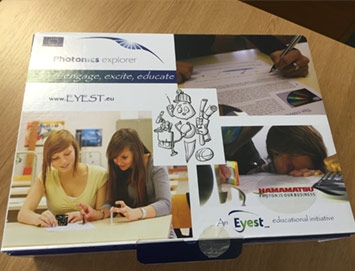
He went around schools in Europe asking teachers what kind of experiment kit he should design and develop. Then, he found out that almost all teachers were doing the same type of experiments in class and most of those included topics like optics and handling of lenses, interference, polarization and colors.
“This kind of knowledge really sinks in if it is taught ‘hands-on’ rather than merely learning theory from textbooks. And that is why we have made these experiment kits. The kits include an instruction manual, so students can learn while carrying out experiments on their own,” says Prof. Thienpont. The experiment kits were then tested and approved at 50 schools, response and feedback gathered from teachers and students, and improvements made. The kits thus produced were given the name ”Photonics Explorer kit” since the kits help students explore the field of optics and photonics on their own.
The development of the kit was complete, but he next faced the problem of how to mass produce the kits and distribute them to the schools. The funds Prof. Thienpont had received were only for development work and he had no idea of how to obtain the funds needed to mass-produce and distribute the kits.
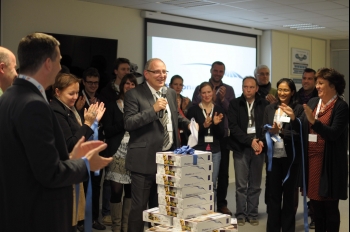
A company manager gave him a hint. At a get-together meeting for an event, Prof. Thienpont tried talking about the issue with a company manager, and asked him, “Your company is growing fast, but can you easily find good researchers and engineers to hire?”
The answer to Prof. Thienpont’s question was “No” and he continued, “This is a big problem at the moment.” Prof. Thienpont told the man, “We are trying to deal with that problem and are reorganizing a system to teach scientific technology, optics and math in middle schools.” The man was astonished and said, “I’m very interested in what you are trying to accomplish.”
Prof. Thienpont talked about his idea of distributing Photonics Explorer kits to middle school students. And the man asked, “How much is that going to cost?”
Prof. Thienpont answered, “It won’t cost very much. Each kit costs about 150 Euros. One kit lasts for 5 years or more and one kit can be used for at least 2 classes and therefore 50 students.”
The man then said, “That’s great!” and he further asked, “how do you go about distributing them to the schools?” Prof. Thienpont replied, “If you will tell me the name of the school, I will go there and first of all show the teachers how to use them.”
The man continued asking, “Can you get them to the schools that my employee’s kids go to every day?” Prof. Thienpont then said, “Sure I can do that. Please ask the names of the schools to your employees and just tell me them.” The man then said, “Great, I will put up money for all of this.”
It was a great idea. If a company wanted to do something good for their employees, all they would have to do is ask, “What school are your kids going to?” Once they knew the name of the school, Prof. Thienpont’s team could then invite the teachers at that school, offer them the kits, and teach them how to use the kits. All the company would have to do is supply the funds.
The kit gives the girl students confidence
The Photonics Explorer kit is currently distributed mainly in Europe, but Prof. Thienpont is dreaming about distributing them to the developing countries such as Africa and South America. Of course, we can’t wait to get the Japanese version. To make that happen, Prof. Thienpont is waiting for assistance from enthusiastic Japanese teachers who can help with the translation work.
Currently, over 3,000 of these kits have been distributed in Europe and some 150,000 to 160,000 students are learning from the kits each year. The students will in this way learn to like physics and photonics more and more and, if they become skilled from this, then that could be called the greatest possible result.
Prof. Thienpont and his staff had in fact asked a research agency to assess the effectiveness of these kits. The agency investigated whether the kids felt any change in their interest in science after using the kits compared to the period before using the kits. One of the results obtained from this survey was that girl students became much more confident about their skills and potential than before.
When they first started using the kits, the girls said, “Oh no, this will be impossible for me!” The boys on the other hand said, full of confidence, “Let me try it!” But once they were made to use it, most boy students weren’t very skillful while the girls turned out to be better at performing the experiments. This gave the girl students confidence. In other words, the kits not only helped the girls learn, but also were found to make them more confident,” says Prof. Thienpont with a smile.
What’s important is to keep on moving ahead
The Photonics Explorer kits are steadily spreading throughout Europe and middle school teachers now have a Facebook account where they can exchange information about the kits. In one sense, the kits have contributed to building a community between teachers. However, Prof. Thienpont says that is merely one small step. In other words, getting students absorbed in the STEM (science, technology, engineering, mathematics) fields should not be a one-time thing but rather students’ interest should be kept constantly high through primary school, middle and high school, and college. If it stops somewhere along the process, then the students’ enthusiasm will fade away. So, students need continuous guidance.
“Besides schools, we also make efforts to link photonics with Fab Labs.(*2) The Fab Lab is a place having various types of machine tools and equipment and where everyone can join to build robots or vehicles as desired. The conventional Fab Lab allows working with electrical engineering and mechanical engineering tools, and also allows to acquire programming skills. However, it had nothing involving photonics. So we decided to also incorporate photonics into the Fab Labs and started working on a project to change the conventional Fab Labs into PHABLABS (Photonics enhanced fAB LABS).” Prof. Thienpont also adds that, “We want to say this to young people. If you want to make something new, then building robots or programming microprocessors is not enough. You will also need to add the fundamentals of photonics to your plan.”
*2 Fab lab is the abbreviation of fabrication laboratory. It is an experimental citizen’s workshop network equipped with a variety of digital and analog machine tools.
Classrooms where kids can find a teacher they admire
We asked Prof. Thienpont to give a message about the future education, especially for teachers. He answered, “This is a very simple message…” and then made the following comment:
“We need good examples for the children in the classroom. I mean we need teachers who are like role models to function as the focus of children’s interest. Teachers must not only be thoughtful and kind to the children but must also teach them what life is all about. And teachers should tell the children that life is rewarding, but that it doesn’t come easy.”
About a couple of months before this interview, Prof. Thienpont met with the king of the Belgians and explained photonics to him. At that time, the king asked him, “How do you see the future?” Prof. Thienpont answered, “Well, I think the future does not look bright.” And he continued, “I am really worried about the next generation. If you could do something in your role as king, I would ask that you invest in providing excellent teachers. I would like you to raise the level of teachers and give them as much time as possible to deliver wonderful lessons that boost children’s desire to learn.”
Prof. Thienpont believes it is essential for teachers to revitalize themselves as professionals. He also comments, “Instead of giving children PCs and tablets, try giving them Lego and Meccano (construction toys) or something they can assemble and build. This will drive them to use their imagination and point them toward thinking that they can do this or they can do that.”
“What I want to say to children is that life is wonderful, but things don’t always go smoothly. But you can gain something even in difficult times. It is easy to say, ‘Study hard’ but what is more important is what new things can you accomplish with the new knowledge you gained from studying. More often than not, teachers don’t tell students the goal behind their lectures and studying the courses and that is why children lose interest in it.”
Talking is easy but doing is hard. That is exactly why Prof. Thienpont developed the Photonics Explorer kit and started distributing it to children. And that effort is starting to pay off.
Changing the world by fusing other technologies with photonics
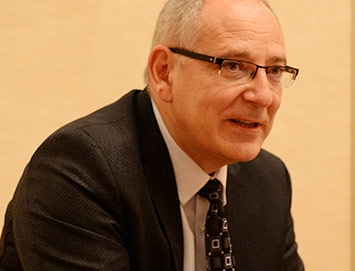
Well now, photonics is called a Key Enabling Technology(*3) that supports all types of industrial fields, but how will it be applied in the future?
“There is no doubt that photonics will continue to be a critical Key Enabling Technology. Photonic technology itself is drastically evolving and better lasers and more highly sensitive detectors will appear on the scene. It will also likely evolve toward mega-photonics that deals with very high power or energy and nanophotonics that handles extremely small regions. In this way things will be accomplished that no one was able to do in the past,” says Prof. Thienpont. However, he also adds, “The real innovation will happen when photonics is linked with other key enabling technologies. By combining photonics with other technologies such as biology, advanced materials and artificial intelligence, we will be able to create technologies that will truly change the world.”
However, there is one concern. Photonics engineers, students, and researchers are not ready yet. Prof. Thienpont goes on to comment, “We currently have superb photonics engineers and biotechnology engineers. However, there are only very few who can really combine the best of these technologies. This means we absolutely must review our educational system. We have to make a more interdisciplinary educational system encompassing more fields.” This is obviously not going to be easy because we need to develop human resources capable of deeply exploring one field and at the same time merging different fields together from a broad perspective. Prof. Thienpont feels a sense of anxiety about this problem.
He goes on to say, “We have built up a society and economy that relies on high technology and innovation, yet we have not nurtured the right human resources for continuously supporting and innovating that technology. For example, how do we respond if a bridge collapses, a nuclear reactor malfunctions or an epidemic spreads because of a mistake made at a bio-research facility? In other words, knowledge must come with accountability. We must work hard and wisely to deal with the issue while accepting responsibility for the outcome. I don’t want to give a negative message, but I believe our generation must constantly keep asking ourselves: What is currently happening? Why is it happening? Are we on the right track or should we turn the tide?”
*3 Key Enabling Technologies (KETs):These are a group of six technologies viewed as very important by the European Union (EU) as a basis for innovation, and refer to micro and nanoelectronics, nanotechnology, industrial biotechnology, advanced materials, photonics, and advanced manufacturing technologies. These technologies will have more applications in all industrial fields and are anticipated to play a critical role in economic growth and solution of social problems. (References: https://ec.europa.eu/growth/industry/policy/key-enabling-technologies_en)
●
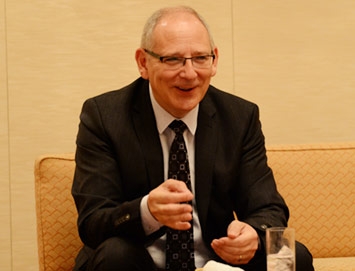
From the very start when Prof. Thienpont thought about spreading photonics to industry, he believed that photonics would prove necessary for the future industrial world. The reason for that of course lies in his belief in the latent possibilities of optical engineering, yet another major reason is that he was inspired by science fiction movies.
“It is Star Trek, not Star Wars. My generation grew up with Star Trek and with Mr. Spock who had the strange ears... do you know about him?” laughs Prof. Thienpont. “In this TV series, they had laser tractor beams, phaser guns, transponders, and universal translators. At the time, those were only imaginary things, but when we see this movie now, well my smartphone looks like their transponder, only more sophisticated, because it includes a computer and a universal translator. It has an incoming call tone and allows talking to people far away...”
He loves science and enjoys working along with wonderful people, he helps other people live a higher quality of life, and he provides new opportunities for the younger generation. Being able to do this type of work is a source of limitless enjoyment for Prof. Thienpont. His insatiable curiosity and great enthusiasm about his work will be infectious to those around him.



